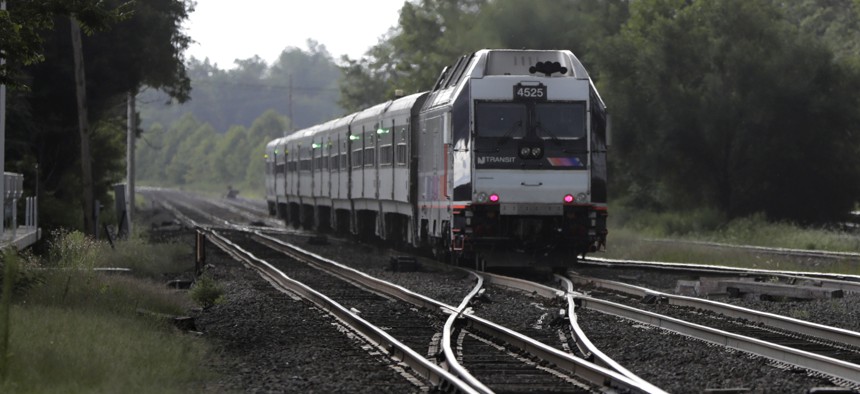‘At-Risk’ Railroads Hit Safety Equipment Deadline, Officials Say

This Aug. 3, 2018 file photo shows a New Jersey Transit train leaving the Bound Brook Station in Bound Brook, N.J. AP Photo
After delays, Association of American Railroads staff are confident the industry will implement positive train control where federally mandated no later than Dec. 31, 2020.
WASHINGTON — All nine railroads once considered “at-risk” of missing key deadlines for implementing a legally required safety measure, positive train control, have installed the necessary equipment, according to the Association of American Railroads.
Positive train control communications systems slow or stop trains to prevent collisions, overspeed derailments, work zone incursions, and going through wrongly positioned switches. Installing the equipment is the first step toward actually using the PTC systems to avert life-threatening crashes.
The Railway Safety Improvement Act of 2008 first mandated that 40 freight and commuter railroads execute PTC along track where passenger and hazardous materials trains run, but the deadline was pushed to the end of last year
If railroads installed all the necessary equipment by that date and began advanced field testing on at least one track segment, or any field testing at all, they could negotiate an alternative schedule with the Federal Railroad Administration—ensuring interoperability no later than Dec. 31, 2020.
AAR senior staff said Friday during a media briefing at their D.C. headquarters that all railroads met the equipment deadline and, among freight railroads, PTC is operational along 83 percent of the approximately 54,000 route miles required to use the technology.
“All the railroads met the [equipment] deadline. I will say, some of them didn’t have a lot of time to spare,” said Mike Rush, senior vice president of safety & operations for the trade association. “They were all commuter railroads, but at the end of the day—maybe to the surprise of some—they all met the deadline. And I think [the Department of Transportation] is very thankful for that.”
In September, the Government Accountability Office issued a report expressing concern about nine commuter railroads that had failed to install 90 percent of PTC hardware by August: New Mexico Rail Runner, CapMetro, New Jersey Transit, Altamont Corridor Express, MARC, Trinity Railway Express, Tri-Rail, Caltrans, and SunRail.
But now that that’s done, both freight and commuter railroads must ensure their PTC systems form a seamless network because locomotives and trains often move from one line to another.
“We’ve got the structure figured out, it’s just putting it into play and making sure it works,” Rush said.
“We will be done [on deadline],” he added.
The National Transportation Safety Board on Monday urged full implementation of PTC as part of the agency’s biannual “most wanted” list of transportation safety improvements.
Since the 2008 train collision in Los Angeles’ Chatsworth district that killed 25 people and led to the federal PTC mandate, 20 PTC-preventable accidents have claimed the lives of 24 people and injured 358 others, the board has said.
“We are counting on industry, advocates, and government to act on our recommendations,” said Robert Sumwalt, NTSB chairman, in a statement. “We are counting on the help of the broader safety community to implement these recommendations.”
Rush said railroads were already working on their own joint PTC solution when the 2008 mandate forced them to start from scratch.
Since 2008, train accidents per million train-miles are down 23 percent to 2.47 accidents as of 2017, according to AAR. Employee casualty rates are down 7 percent to 1.95 deaths during the same timespan, but in both cases “we have been plateauing,” Rush said.
In 2017, trespassers accounted for 62.3 percent, or 513, of all rail-related fatalities and grade crossings—vehicles crossing train tracks—accounted for 32.8 percent, or 270.
Trespassers are hard to stop, particularly people who are attempting to commit suicide, but the best way to curb grade crossing fatalities is to eliminate crossings through design changes like overpasses, Rush said. For example, the Chicago Region Environmental and Transportation Efficiency initiative is a public-private partnership consisting of about 70 separate projects, some of which involve removing grade crossings because the city is the choke point for six out of seven Class 1 freight railroads—the biggest ones.
The industry is also exploring new technologies like wheel temperature detection, which identifies sticking brakes or brakes failing to deploy more often than human inspectors do.
“We’ve come a long way since the days of the robber barons,” Rush said, noting that the sector's injury and casualty rates compare favorably to many others.
Previously, on Route Fifty:
Dave Nyczepir is a News Editor at Route Fifty and is based in Washington, D.C.
NEXT STORY: Using Nudges and Shoves to Encourage Better Transportation Choices






